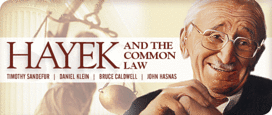Lead Essay
In his lead essay, lawyer and legal theorist Timothy Sandefur proposes that Friedrich Hayek’s understanding of law and justice is flawed: Spontaneous order may be a descriptively accurate concept, but it has little or no effective normative content. Depending on how one chooses to focus, those who wish to reform a spontaneous order are either constructive rationalists — thus, outside the order, and presumptively bad — or they are manifestations of the spontaneous order itself, which changes over time. He suggests that the Hayekian approach to legal reform is simply “be careful,” and that this is not terribly helpful advice.
Response Essays
In his response essay, John Hasnas offers solutions to Sandefur’s problems. He suggests that genuine spontaneous orders can be recognized as having no final decision makers, and hence as recognizing a multitude of individual choices. Constructed orders have a final decision maker, and do not respect individual choice. The normative benefits of a spontaneous order are therefore clear: It offers a greater scope for peaceful cooperation, while tending to reduce coercion incrementally. Still, Hasnas admits, spontaneous orders will always be “riddled with injustice,” in part owing to our own limited knowledge and virtue. He suggests that one key missing insight helps rescue much of Hayekian legal thought: the notion that laws, too, respond to market forces.
Daniel Klein argues that much of the fuzziness in Hayek’s writing was strategic — designed to bring lapsed liberals back into the fold, or to appeal to people who would never accept an unvarnished liberalism. Still, Klein finds great value in Hayek’s work. He argues that, while out of fashion at the time, Hayek’s own willingness to be indeterminate, and to embrace indeterminateness, was both consistent with the Smithian understanding of the social order — and predictive of some of the best work being done today in economics and in other social sciences.
Bruce Caldwell proposes two solutions to Sandefur’s problems. The first is to acknowledge that Hayek was a rule utilitarian, albeit one who recognized that the rules we have inherited are the products of a spontaneous order. The second is to claim that Hayek wasn’t proposing any normative conclusions at all — he was simply making observations in a value-neutral way, as might befit a member of the Austrian School, which was deeply influenced by Max Weber’s ideal of a value-neutral social science. Both approaches have their strengths and weaknesses, Caldwell admits, yet in the end he cannot accept Sandefur’s claim that there is no meaningful distinction between spontaneous and designed orders. Although the difference can be difficult to put into words, we know them when we see them.
The Conversation
Related at Cato
» Book Forum: The Ideas and Impact of F. A. Hayek, February 2, 2004, featuring Bruce Caldwell
» Article: F. A. Hayek and the Common Law by Ronald Hamowy, Cato Journal, Vol. 23, No. 2 (Fall 2003).
» Biography: The late Friedrich Hayek’s page at the Cato Institute; Hayek was a Distinguished Senior Fellow.

